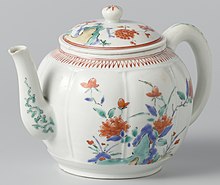
Japanese export porcelain includes a wide range of porcelain that was made and decorated in Japan primarily for export to Europe and later to North America, with significant quantities going to south and southeastern Asian markets. Production for export to the West falls almost entirely into two periods, firstly between the 1650s and 1740s,[1] and then the period from the 1850s onwards.[2]
The wares produced are a complex and varying mixture of styles, based on Chinese porcelain, the local Japanese pottery and porcelain (itself much influenced by Korean porcelain), and European styles and tastes. Often the shapes were dictated by the export markets, but the decoration was predominantly East Asian in style, although quite often developed from Dutch imitations of Chinese pieces. In the first period the great majority of the wares were produced in the area of Arita, in the old Hizen Province and are covered by the terms Arita ware (or Hizen ware), Imari ware and Kakiemon, all of which have complications in their meanings in English.[3]

In the later period, Satsuma ware was produced almost entirely for export, and factories began to brand their wares, with Noritake and Nikko Ceramics being well-known in the West.[4]